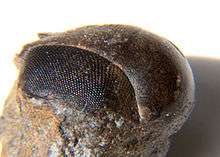Cyclopyge (trilobite)
Cyclopyge is a genus of small to average size trilobites that lived during the Ordovician. Like all members of the family Cyclopigidae, it has very large convex eyes, that cover most of the free cheeks, and in some species touch each other. The eyes almost touch the large glabella. The occipital ring has merged with the rest of the glabella. The glabella does not extend into a frontal thorn. The cephalon lacks genal spines. The 6 thorax segments have short pleurae. The pygidium is rather large, and often rather effaced. These are features that also occur in other Cyclopygidae, and are indications of a pelagic lifestyle.[1]
| Cyclopyge | |
|---|---|
 | |
| Cyclopyge sp., cephalon 13 mm (0.51 in) long Alnif, Morocco | |
| Scientific classification | |
| Kingdom: | Animalia |
| Phylum: | Arthropoda |
| Class: | †Trilobita |
| Order: | †Asaphida |
| Family: | †Cyclopygidae |
| Genus: | †Cyclopyge |
| Type species | |
| Egle rediviva | |
| Species | |
Hawle & Corda, 1847, | |
| Synonyms | |
| |
Taxonomy
The genus was first named Egle by Barrande, but that name was not available, since it was used by Robineau-Desvoidy before for a willow catkin fly of the Anthomyiidae family.
Species previously assigned to Cyclopyge
- C. binodosa = Pricyclopyge binodosa
- C. genatenta = Prospectatrix genatenta
Species that may be confused with Cyclopyge
- The agnostid trilobite Pseudagnostus cyclopyge, or previously known as Agnostus cyclopyge.
- The agnostid trilobite Rhaptagnostus cyclopygeformis, or previously known as Agnostus cyclopygeformis.
- The butterfly previously known as Cyclopyge Mielke, 2002.
- The millipede Rhamphidarpoides cyclopyge, belonging to the Spirostreptida order.
Distribution
As pelagic creatures, cyclogygids were not bound to shallow waters surrounding continents and islands. At the time they lived, continents weren't blocking the exchange between different parts of the ocean, and this means they probably had large distributions, comprising one or more climate zones worldwide. Cyclopyge is well known from the Czech Republic, Morocco, England, Sweden, Canada (Newfoundland) and the United States.[1]
- Cyclopyge recurva occurs in the Ordovician of China (Pagoda Formation of southwestern Shaanxi).[2]
References
- Whittington, H. B. et al. Part O, Treatise on Invertebrate Paleontology. Revised, Volume 1 – Trilobita – Introduction, Order Agnostida, Order Redlichiida. 1997
- Zhou Zhiyi; Zhou Zhiqiang (2009). "Ordovician cyclopygid trilobites from the Pagoda Formation of southwestern Shaanxi, China". AAP Memoir. 37: 87–101. Archived from the original on 20 June 2013. Retrieved 7 June 2013.